
French postcard by E.D.U.G., no. 328. Photo: Sam Lévin.

German postcard by Krüger, no. 902/345. Photo: Gérard Decaux.
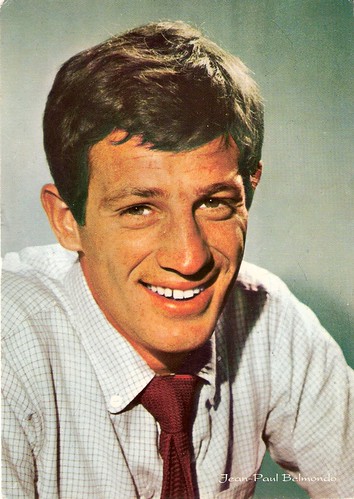
Italian postcard in the series Artisti di sempre by Rotalfoto, Milano, no. 355.

French postcard by E.D.U.G., no. 77. Photo: Lucienne Chevert.

Italian postcard. Photo: Dear Film. Publicity still for Les tribulations d'un Chinois en Chine/Chinese Adventures in China (Philippe de Broca, 1965).
Bébel
Jean-Paul Belmondo was born in Neuilly-sur-Seine, a commune in the western suburbs of Paris, in 1933. He was the son of Paul Belmondo, a sculptor of Sicilian descent.
Young Jean-Paul did not perform well at school but developed a passion for boxing before he decided that his future lay in acting. After a number of attempts, he finally gained admittance to the Paris Conservatoire in 1952, although his tutors were not overly optimistic about his prospects. It was here that he acquired the nickname 'Bébel'.
In the mid-1950s, he appeared in a few theatrical productions, often to great acclaim, before beginning a film career in 1956 with Les Copains du dimanche/The Sunday Friends (Henry Aisner, 1956-1958). The film was never played in public cinemas though and his episodes in À pied, à cheval et en voiture/On Foot, on Horse, and on Wheels (Maurice Delbez, 1957) were even cut before release.
Soon bigger roles followed in the spoof thriller Sois Belle et Tais-Toi/Be Beautiful But Shut Up (Marc Allégret, 1957) - his first co-starring role with Alain Delon, the hit Les Tricheurs/The Cheaters (Marcel Carné, 1958) and À double tour/Web of Passion (Claude Chabrol, 1959) with Madeleine Robinson.
It was in 1958 that the 25-year-old Belmondo attracted the attention of a former critic turned filmmaker Jean-Luc Godard. The latter was impressed by the actor’s spontaneity and cast him first in a quirky short, Charlotte et son Jules (1959).

Dutch postcard by SYBA, no. 44/364.

French postcard in the Collection Cinéma series by Editions Art & Scene, Paris, no. CF 83, 1995. Photo: Raymond Cauchetier, 1959. Jean-Paul Belmondo in A bout de souffle/Breathless (Jean-Luc Godard, 1960).

French postcard by Editions Art & Scene, no. CF 98, 1996. Photo: R. Cauchetier. Jean-Paul Belmondo and Jean Seberg in A bout de souffle/Breathless (Jean-Luc Godard, 1960).
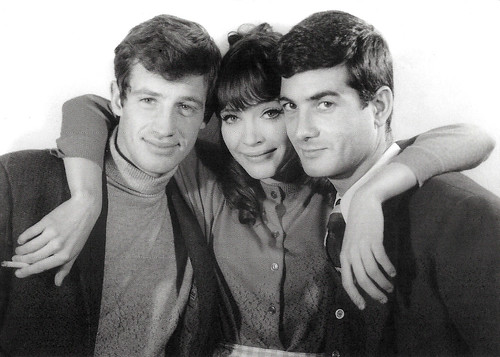
French postcard in the Collection Cinéma by Editions Art & Scene, Paris, no. CF 102, 1996. Photo: R. Cauchetier. Jean-Paul Belmondo, Anna Karina and Jean-Claude Brialy in Une femme est une femme/A Woman Is a Woman (Jean-Luc Godard, 1961).

French postcard by La Cinémathèque Française. Photos: DR / Georges Pierre. Jean-Luc Godard, Jean-Paul Belmondo and Anna Karina during the shooting of Pierrot le Fou (Jean-Luc Godard, 1965).
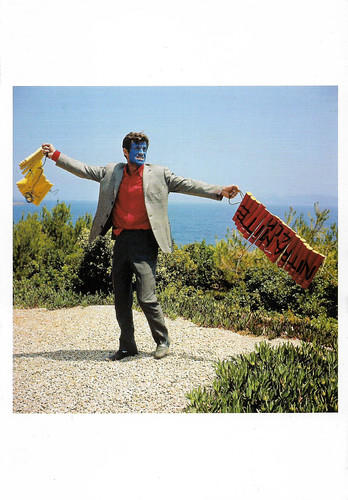
French postcard by La Cinémathèque Française. Photo: Georges Pierre. Jean-Paul Belmondo in Pierrot le Fou (Jean-Luc Godard, 1965).
Breathless
Stardom came in 1959 when Jean-Paul Belmondo took the lead role of a sympathetic gangster in Godard’s landmark feature debut A Bout de souffle/Breathless (Jean-Luc Godard, 1960).
At AllMovie, Lucia Bozzola writes: "Belmondo perfectly embodied the cool youthful rebellion guiding Godard's trailblazing cinematic style, rendering Belmondo the Gallic James Dean and heir apparent to Michel Simon and Jean Gabin." This film launched not just Belmondo’s film career but also the 'Nouvelle Vague', the New Wave of the French cinema.
Belmondo would play a major part in the Nouvelle Vague during the early 1960s with roles in Une femme est une femme/A Woman Is a Woman (Jean-Luc Godard, 1961) and Pierrot le fou/Pierrot Goes Wild (Jean-Luc Godard, 1965).
Besides these classics he also acted in a stream of other excellent films: Classe tous risques/The Big Risk (Claude Sautet, 1960) with Lino Ventura, Moderato cantabile/Seven Days... Seven Nights (Peter Brook, 1960), La Ciociara/Two Women (Vittorio De Sica, 1960) with Sophia Loren, and La Viaccia/The Lovemakers (Mauro Bolognini, 1961) with Claudia Cardinale.
He played a priest in the dark World War II drama Léon Morin, prêtre/Leon Morin, Priest (Jean-Pierre Melville, 1961). Very popular was the Swashbuckler Cartouche (Philippe de Broca, 1962) again with Cardinale. In Un singe en hiver/A Monkey in Winter (Henri Verneuil, 1962) he appeared with Jean Gabin. All that and the two films he made with Jean-Pierre Melville, Le Doulos/The Fingerman (Jean-Pierre Melville, 1962) and L’Aîné des Ferchaux/An Honorable Young Man (1963), which became modern classics of the Film Noir.

West-German postcard by Kolibri / Friedrich W. Sander-Verlag, Minden/Westf., no. 2326. Photo: Gloria-Film. Jean-Paul Belmondo in Lettere di una novizia/Letters by a Novice (Alberto Lattuada, 1960).

Small Czech collectors card by Pressfoto, Praha, no. S 125/5, 1966. Photo: Eleonora Brown and Jean-Paul Belmondo in La ciociara/Two Women (Vittorio De Sica, 1960).

East-German postcard by VEB Progress Film-Vertrieb, Berlin, no. 2442, 1965. Jean-Paul Belmondo and Jean Seberg in Échappement libre/Backfire (Jean Becker, 1964).

Italian postcard by Rotalfoto, Milano, no. 1087.
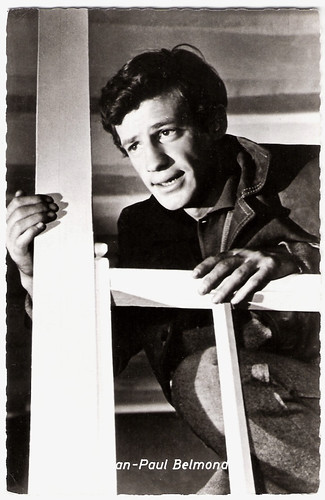
German postcard by Kolibri-Verlag G.m.b.H., Minden-Westf., no. 1334.
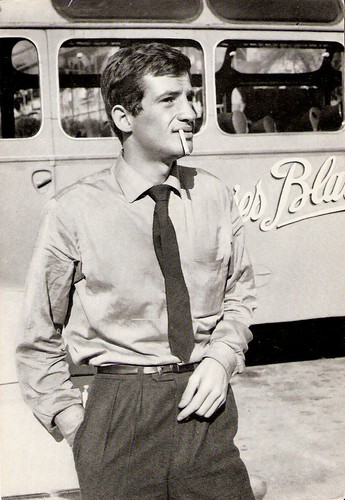
German postcard by WS-Druck, Wanne-Eickel, no. 559.
Mainstream
With L’homme de Rio/That Man from Rio (Philippe de Broca, 1964), Jean-Paul Belmondo switched to commercial, mainstream productions and became a big comedy and action star in France. During the production of their next hit comedy Les tribulations d'un Chinois en Chine/Chinese Adventures in China (Philippe de Broca, 1965), Belmondo fell in love with his co-star Ursula Andress.
Following the example of Alain Delon, he founded his own production company, Cerito Films, which produced around a dozen of his films over the next decade. Until the mid-1980s, his typical characters were either dashing adventurers or more cynical heroes in such films as Cent mille dollars au soleil/Greed in the Sun (Henri Verneuil, 1964) with Lino Ventura, Le Voleur/The Thief (Louis Malle, 1967), La Sirène du Mississipi/Mississippi Mermaid (Francois Truffaut, 1969) with Catherine Deneuve, Borsalino (Jacques Deray, 1970) opposite Alain Delon, and Stavisky... (Alain Resnais, 1974).
Returning to his athletic roots, Belmondo became renowned for doing his own stunts as well as for his charming screen presence in such action films like the James Bond parody Le Magnifique/The Magnificent One (Philippe de Broca, 1973) with Jacqueline Bisset, L'Animal/The Beast (Claude Zidi, 1977) with Raquel Welch, and Le Professionnel/The Professional (Georges Lautner, 1981).
Belmondo was one of France's biggest box-office stars of his time. He ceased to perform all the stunts himself after an accident during the filming of Hold-Up (Alexandre Arcady, 1985) with Kim Cattrall. He made a spectacular return to the theatre in 1987, appearing in 'Kean'.In the following decades, he continued to perform on stage to great acclaim, whilst simultaneously pursuing his film career.

German collectors card, no. 76. Jean-Paul Belmondo in Cartouche (Philippe de Broca, 1962).

Czech collectors card by Pressfoto, Praha (Prague), no. S 125/6, 1966. Jean Gabin and Jean-Paul Belmondo in Un Singe en Hiver/A Monkey in Winter (Henri Verneuil, 1962).

Spanish postcard by Postal Oscarcolor, no. 481. Photo: Jean Rochefort, Ursula Andress and Jean-Paul Belmondo in Les tribulations d'un Chinois en Chine/Up to His Ears (Philippe de Broca, 1965).

Italian postcard. Photo: Dear Film. Ursula Andress and Jean-Paul Belmondo in Les tribulations d'un Chinois en Chine/Up to His Ears (Philippe de Broca, 1965).
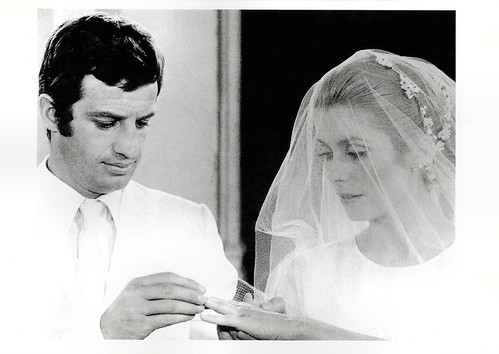
French postcard in the Collection Magie Noire by Éditions Hazan, Paris, no. 6247, 1991. Catherine Deneuve and Jean-Paul Belmondo in La Sirène du Mississipi/Mississippi Mermaid (François Truffaut, 1969).

Belgian postcard by Raider Bounty / Joepie. Jean-Paul Belmondo and Alain Delon in Borsalino (Jacques Deray, 1970).
No César
Jean-Paul Belmondo later preferred mostly dramatic roles. In 1989 he was awarded the César for his performance in Itinéraire d'un enfant gâté/The Lion (Claude Lelouch, 1988). He refused to take the trophy because César, the sculptor who designed the award and gave it his name, had once expressed bad opinions about the work of his father.
Another popular dramatic film was Les Misérables (Claude Lelouch, 1995). Jean-Paul Belmondo married twice. In 1953, he married dancer Élodie Constantin, with whom he had three children: Patricia (1958), Florence (1960), and Paul (1963). Paul became a Formula One driver; his eldest daughter Patricia was killed in a fire in 1994.
In 1966, due to the well-publicised affair between Belmondo and Ursula Andress, Belmondo and his wife divorced. Later he had a long relationship with Italian actress Laura Antonelli. In 1989, he met Nathalie Tardivel who was 24 years old at the time. Belmondo married her in 2002. In 2003, at the age of 70, his fourth child Stella was born. In 2008, Belmondo and Tardivel divorced.
In 2001, he suffered a stroke and for years he was absent from stage and screen. In 2007 he became 'Commandeur de la Légion d'honneur' (Commander of the Legion of Honour), France’s highest accolade.
The last film in which he starred was Un homme et son chien/A Man and His Dog (Francis Huster, 2009), a remake of the classic Umberto D (Vittorio De Sica, 1952). It was not well-received.
In 2011, the Cannes Film Festival paid tribute to him by giving him a special Palme d’Or to commemorate his exceptional body of work. Since then he appeared in some documentaries on his work, including Belmondo ou le goût du risque (Jérôme Wybon, 2017).

East-German postcard by Progress Film-Verleih, Berlin, no. 105/77.

Romanian postcard by Casa Filmului Acin, lei 2.

French postcard by Combier, Macon in the Series Les geants du cinema, no. 1. Illustration: Jean-Pierre Gillot.

French autograph card. Photo: B. Charlon.

French autograph card. Photo: Sonneville.

French postcard in the 'Les acteurs français vus par Solo' series by Editions F. Loubatières, Toulouse, no. 6. Illustration: Solo.

French postcard by E.D.U.G., no. 160. Photo: Sam Lévin.
Sources: Lucia Bozzola (AllMovie), James Travers (French Films), Wikipedia, and IMDb.
2 comments:
Merry Christmas!
All the best!
:)
Here's one star familiar to me, but I haven't seen enough of his work. Thank you for the overview, and the great photos.
Post a Comment